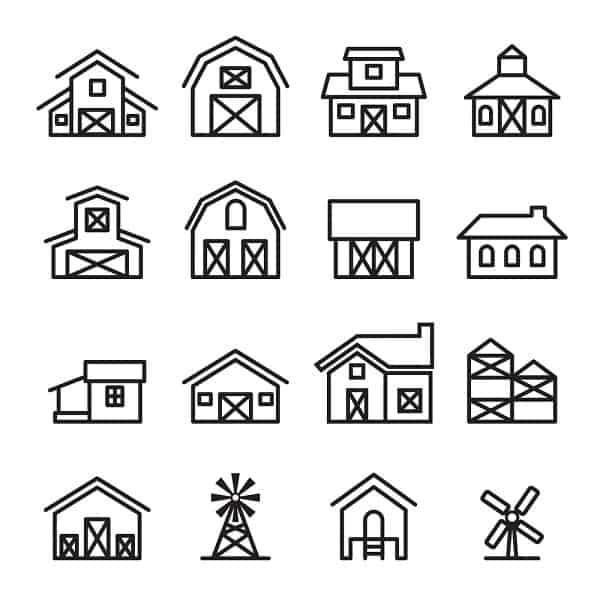Everything You Need To Know About Working Out Your Shed Roof Pitch
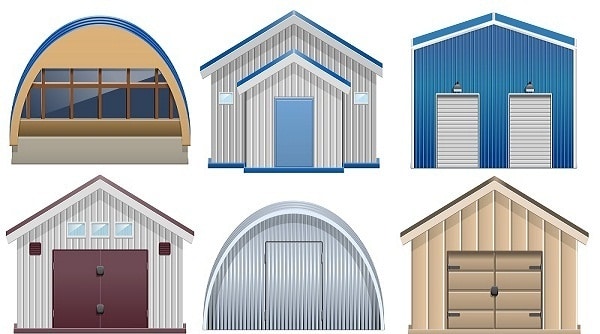
What you need to know before you start putting together your shed roof
Quick Navigation
So, by now you may or may not have figured out that framing in a wood shed is not as hard as you though it was. At least with regard to the floor and walls, but if you are like me, the idea of putting the roof together is more than just a little scary.
While a flat roof is relatively easy, when it comes to a sloped roof, you must understand what shed roof pitch is and how to calculate it before getting started or your efforts could end in disaster.
Follow along as we go through everything you need to know about shed roof pitch and your roof is sure to turn out just fine in the end. Don't worry, if I can build a shed roof, anyone can!
Shed Roof Pitch Info ( Just Before You Start ... )
Let's get started by stating the obvious, shed roof pitch is the amount of slope your shed roof has. It is measured by the amount of rise in the roof compared to the run of the roof. Here is a simple diagram that explains this term:
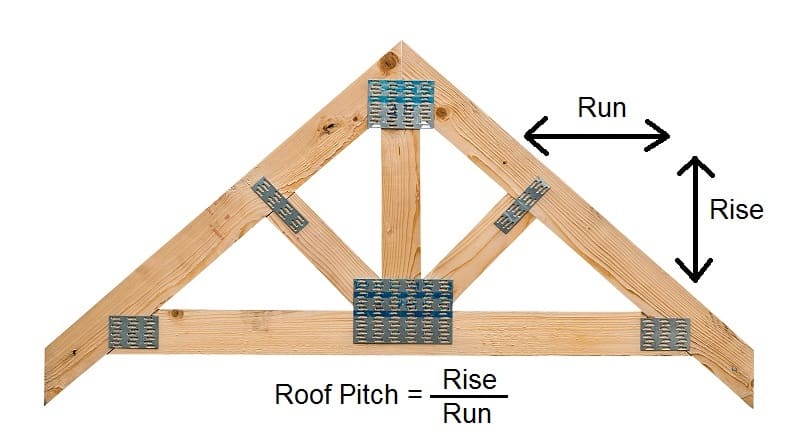
Shed Roof Pitch - Rise over Run
How important is having the right shed roof pitch? This depends in part on where you live, in part on what the weather in your area does, and in part what your personal tastes and building skills happen to be.
Bear in mind there is significantly more work involved in building a pitched roof than in building a flat one.
The weather plays a very large part in the amount of pitch your shed roof is likely to need. Areas where it tends to rain or snow may need a much steeper pitch than in areas with little to no rain or snow.
You should also take into consideration that flat roofs hold up much better in strong winds than those with a steep pitch. One quick way to see what type of shed roof pitch might be best for where you live is to look at your home, your neighbors' homes, and sheds in your local area.
Planning Your Shed Roof - Easy Does It!
In this section, we are going to take a good look at the basics of shed roof pitch, which is one of the most important aspects of building the roof for your shed.
We are also going to go over several other vital pieces of information that will prove to be invaluable in designed and building your shed roof.
What Type of Roof Do You Want to Build?
Long before you start to worry about your shed roof pitch, you must decide on what type of shed roof you are going to cap all of your hard work with.
Obviously, if you are going to install a flat roof on your shed, you won't have to worry about any amount of shed roof pitch as a flat roof has a pitch or 0/0, in other words, it rises zero inches for every zero inches of run.
Beyond this there are several different styles worth considering, including:
- Barn or Gambrel style roof
- Gable style roof
- Hip style roof
- Pyramid style roof
- Salt Box style roof
- Standard pitched roof
Each of these styles of shed roof has one or more slopes to them. This means that you must be ready to calculate both the shed roof pitch and any snow load in your area if you are going to build any of these roofs.
However, you should also figure in your own construction abilities as you look the different types of roof. Take a more detailed look at the different types of shed roofs here.
Does Your Permit/Local County or Jurisdiction Require a Particular Pitch?
Remember when you had to go to your local authority to see if you needed a building permit to build your shed in the first place? Did you stop to see if they had any rules or regulations in place regarding shed roof pitch?
While not all local authorities have requirements regarding roof pitch, the last thing you want is to stand proudly back looking at your finished shed, only to have a building inspector tap you on the shoulder and say, “I am sorry, but your shed roof pitch is not within the standards established, or “Where is your permit? You don't have one? You're shed roof has to be taken down.”
The best thing is to have the right answers before you get started. Click here to find out if your local county or city has shed roof pitch requirements.
It is far better to know in advance what you are facing than to build first and then find out you were in error.
What are Low Pitched Roofs?
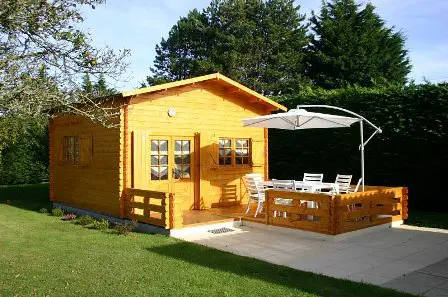
Picnic garden shed with a low pitched roof
Low pitched roofs are described as those with a pitch of 3/12 or less. Having such a low pitch makes walking on your roof much easier and safer.
Low pitched roofs typically cost less to build and require much less in the way of maintenance.
What are Mid Pitched Roofs?

Elegant house with mid pitched roof
A medium pitched roof is one that has a pitch of between 3/12 and 7/12. This range makes up the bulk of new roofs being built on homes and outbuildings in the U.S.
Personally unless you live in an area of extreme snow load, I would recommend you incorporate a shed roof pitch of between 4/12 and 6/12 for optimum results.
What are Steep Pitched Roofs?
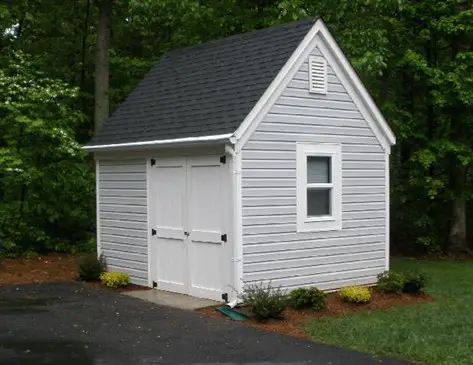
Shed with steep pitched roof
Steep pitched roofs are those with a pitch of greater than 7/12. These roofs require you to have special equipment to walk on them safely. Because these roofs shed snow/ice and rain more easily, they tend to last longer than low pitch roofs.
Calculate Snow Loads
Does it snow where you live? How much? In all reality, if you live anywhere that enjoys snowy winters, you must calcite the snow load your roof will be able to handle before you cut the first board. The snow load on a roof is measured in pounds per square inch, this method uses the ground snow load as its basis.
Whenever you are building any type of commercial, residential, or storage structure in an area that receives snow in the winter, you must consider snow load when choosing the materials you plan to use for your roof and the shed roof pitch needed.
While there is a set of exceptionally complex mathematical formulae you can use to determine the snow load in your area, this involves a lot of research and hard work.
For those of you who are like me, a little on the mathematically lazy side, I recommend you use an online snow load calculator. You will need to obtain certain information such as your local “ground snow load”, you can wait for winter and measure it, or better yet look it up in your local or state building codes.
Be sure to follow the instructions very carefully with any online snow load calculator you plan to use.

One thing to keep in mind is that one foot of fresh snow can weigh anywhere from 3 pounds per square foot all the way up to 21 pounds per square inch, depending on whether you are dealing with light fluffy snow or heavy wet snow.
At the same time, you should also be aware that a single inch of ice weighs in at slightly under 5 pounds, a square foot of inch of ice this thick weighs about 57 pounds.
Here is some detailed snow load information put out by FEMA for you to browse when you have a spare hour or two.
Ventilation
No one could blame you for thinking that keeping the roof of your shed sealed up tight would be better during the winter months. There are a couple of very important reasons why this thought is completely opposite to the truth. Keep in mind that if your roof is not vented, the surface is going to stay warmer than the outside air.
If your shed roof's surface is warm, when you get a healthy covering of snow, the space between the surface of the roof and the snow stays above freezing. This lets the snow that is actually in contact with the roof melt, reducing your risk of ice dams building up.
If your roof is not vented and is heavily insulated, the surface will not stay as warm. As snow hits the roof, some of it might melt, most of it won't. That part that does melt will quickly freeze forming ice dams that trap snow on the roof, rapidly increasing the amount of snow load your shed roof must bear.
How to Measure/Determine Shed Roof Pitch
In the simplest possible terms, shed roof pitch is defined as the amount of rise per foot of run. It is expressed as X/Y, where X = rise and Y = run, for example, 4/12 or 5/12, and so on.
Worth noting is that the higher the first number in the equation is, the steeper the pitch of your shed roof will be. So a roof with a 5/12 pitch is steeper than one with a 4/12 pitch.

Image Courtesy of Carpentry Pro Farmer
This simple diagram will help give you a better idea of how shed roof pitch or for that matter, any other type of roof pitch works.
A couple of points worth noting are that the steeper you make the roof, the more it will cost to build due to an increase in the amount of materials needs, but the steeper the roof is, the longer the roofing materials are likely to last.
Shed Roof Pitch Calculators
The best way to calculate the pitch of your new shed roof is to use an online pitch calculator such as this one here or this one. The only thing you need to know to use these pitch calculator is at least two of the following, run, rise, or angle. Once you enter the appropriate information, the calculator does all of the work.
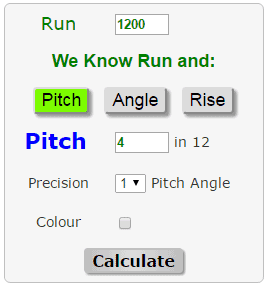
Image courtesy of blocklayer
The calculators will give you whatever piece of information you are missing, you can then use the results to help you determine the best shed roof pitch and ensure you have enough materials to build your roof.
In Conclusion
My guess is that you probably never realized that there would be so much to determining how steep your shed roof should be. In reality, having the right shed roof pitch is vital not only to the structural integrity of your shed, but also its ability to withstand high winds, heavy rains, and heavy snow loads.
One last reminder to check your local codes before getting started or you may find all of your hard work turns out to be for naught when your local inspector tells you to tear it all down.
I hope the information I have pulled together here for you has helped you to gain a better understanding of shed roof pitch, how to calculate it, and why having the right pitch is so important to your shed.
If you like what I have put together for you here, please let me know.
If you have any information you would like to see here, please contact us here.
Let everyone know you enjoyed reading this on Facebook, Twitter, and Pinterest.
Thank you for reading this.
Related Articles:

